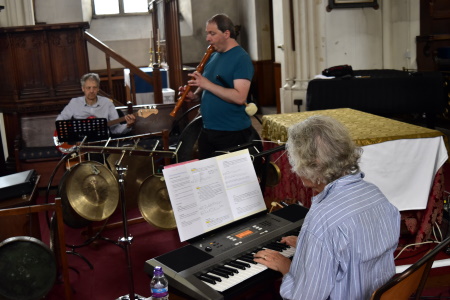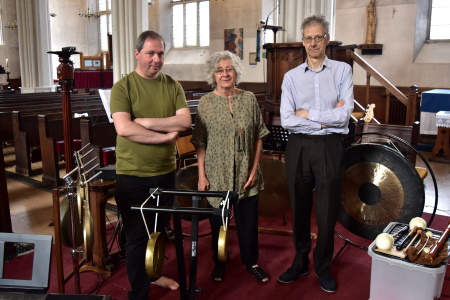Cathedral at Noon
Intuitive Music Aberdeen premieres Nine Bronzes by Haworth Hodgkinson
Saturday 3 August 2019 • 12 noon
St Andrew's Cathedral • 28 King Street • ABERDEEN • AB24 5AX

Review by Alan Cooper
Photos by Graham Denyer
Intuitive Music Aberdeen is an ensemble specialising in music created by the performers in response to text or graphic scores or unconventional notations. Today's concert in the Cathedral at Noon series in St Andrew's Cathedral was a world première of a most unusual and totally fascinating work by Haworth Hodgkinson. It is best described in the programme note supplied by Hodgkinson as follows:
It takes both title and inspiration from a set of nine assorted gongs and tam-tams that Haworth Hodgkinson has collected over the years. These instruments naturally produce complex sounds containing many different pitches, often difficult to reconcile with conventional tuning. The music of the piece is based on the pitches that we hear in the gongs and tam-tams, played on tenor recorder, keyboard and bass guitar, accompanied by the bronzes themselves, as well as electronic sounds made from recordings of the nine bronzes.
To begin with, it was fascinating to see the nine gongs arrayed in order of size round the three performers. The three musicians were there too, ready to go. What on earth was this music going to sound like? What would the gongs themselves sound like? We were soon to find out.
I am always interested in such performances. A considerable part of the fascination for the audience resides in watching the live performance and how the sounds were produced and ordered. Haworth Hodgkinson raised his beater high in the air to signal to the players that he was going to move to the next gong. What would be our reaction to just hearing a recording of the music without seeing how it was produced? This too would be a special fascination. I do not know whether this was intentional but from the sounds only I was reminded of background music from certain Japanese film scores. The gongs and the recorder certainly steered me in that direction. Perhaps Indonesian or Javanese music was echoed too. What a pity that Ravel and Debussy are no longer around. What would they have made of this performance?

As Haworth Hodgkinson said in his programme note, the sounds of the gongs were very complex. These changed very subtly depending on the force of the strikes and possibly on the areas of the gongs hit by Hodgkinson. Each gong sound was radically different and I was amazed to hear how, as promised, the sounds of the recorder, the keyboard or the bass guitar picked up on some of the sound particulates coming from each gong, sometimes amplifying those or, almost jazz-like, running with them. At one point, Mandy Macdonald produced vocal sounds with the sixth gong, at first almost subliminally then more and more clearly.
Each of the live instruments had its place in the spotlight. The recorder was not there in every case and then Mandy Macdonald's keyboard took over with fancy runs, and near the end it was the bass guitar played by Colin Edwards that took over.
All sorts of features were bound up in Nine Bronzes: the science of acoustics, the imagination of musical shaping and colours used by the live instruments and the obvious depth of thought and artistry that had gone into the music. When I was an ignorant teenager I might have thought that this sort of music was just people "faffing about on the various instruments" but listening to and indeed watching Intuitive Music Aberdeen in action I understand more and more how much thought, detailed preparation and intense co-operation has to go into a performance such as this. It held the fixed attention of everyone in the audience and they all said afterwards how much they had enjoyed it.
Links
St Andrew's Cathedral Aberdeen



